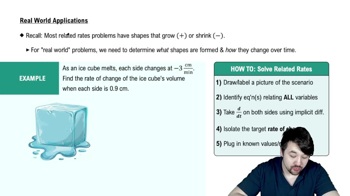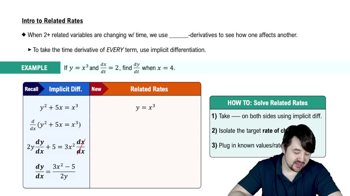Table of contents
- 0. Functions7h 52m
- Introduction to Functions16m
- Piecewise Functions10m
- Properties of Functions9m
- Common Functions1h 8m
- Transformations5m
- Combining Functions27m
- Exponent rules32m
- Exponential Functions28m
- Logarithmic Functions24m
- Properties of Logarithms34m
- Exponential & Logarithmic Equations35m
- Introduction to Trigonometric Functions38m
- Graphs of Trigonometric Functions44m
- Trigonometric Identities47m
- Inverse Trigonometric Functions48m
- 1. Limits and Continuity2h 2m
- 2. Intro to Derivatives1h 33m
- 3. Techniques of Differentiation3h 18m
- 4. Applications of Derivatives2h 38m
- 5. Graphical Applications of Derivatives6h 2m
- 6. Derivatives of Inverse, Exponential, & Logarithmic Functions2h 37m
- 7. Antiderivatives & Indefinite Integrals1h 26m
- 8. Definite Integrals3h 25m
4. Applications of Derivatives
Related Rates
Problem 6a
Textbook Question
At all times, the length of a rectangle is twice the width w of the rectangleas the area of the rectangle changes with respect to time t.
a. Find an equation relating A to w.
 Verified step by step guidance
Verified step by step guidance1
Start by recalling the formula for the area A of a rectangle, which is given by A = length × width.
Since the problem states that the length of the rectangle is twice the width, we can express the length as L = 2w.
Substituting the expression for length into the area formula gives us A = (2w) × w.
Simplify the equation to find the relationship between area A and width w, resulting in A = 2w².
This equation A = 2w² now relates the area of the rectangle to its width.
Recommended similar problem, with video answer:
 Verified Solution
Verified SolutionThis video solution was recommended by our tutors as helpful for the problem above
Video duration:
1mPlay a video:
Was this helpful?
Related Videos
Related Practice






